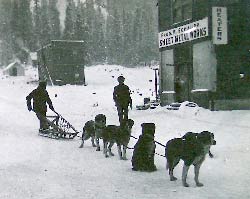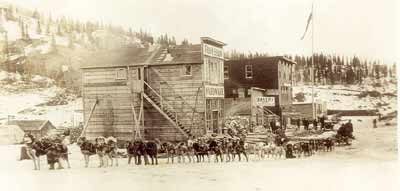
| Home | Artwork | About the Gallery | Local Attractions | Getting Here | Contact Us |
|
Chitina Tin Shop Preservation Plan (excerpts) Submitted to the Alaska Office of History and Archeology,
AHRS# VAL 049 Forward
The Chitina Tin Shop gains its significance for its historic association with the development of Chitina, the Copper River & Northwestern Railway the the Kennecott copper mining era. The oldest of the original town site buildings still standing, the Tin Shop is associated with two prominent pioneers of the region, Fred M. Schaupp and O.A. Nelson.
Historic Background With the arrival of the Copper River & Northwestern Railway in September of 1910, the new town of Chitina also sprouted its own weekly newspaper, The Chitina Leader , published in Cordova. An article in the October 1, 1910 issue entitled "Chitina Has a Future" accurately describes Chitina's significance to the area and to Alaska: "... We are the center and will be the general distributing point for the greatest copper belt ever discovered. ... Chitina is the terminus of the trail to the interior and will derive benefit from all the development of that wonderful country. ... We are the only railroad division point in Alaska and the payroll the railroad makes possible is what every town needs for its success." In a flourish of optimism the article went to state, "As soon as the world at large learns of the wonderful wealth and opportunities our section offers we will see an ever increasing stream of prospectors, tourists and investors coming to our town. ... A more beautiful spot for a city could not exist. We are absolutely sheltered from all wind (sic), have most magnificent scenery, pure water, natural drainage and, in fact, everything one could wish for to make a perfect town." Not uncomplimentary words to be coming from an officer of the town site [development] company.
Indeed, the optimism was well founded as the town and its newspaper prospered over the next twenty years. Business and homes rose on the cleared town site. The prospectors, tourists and investors came, registering at any of several hotels. The trail to the interior became known as the Edgerton Cutoff, and the Alaska Road Commission established a district office and road crew in Chitina in 1918. A school was built and a teacher was employed. (For some reason only single women were employed, with the risk of losing their jobs should they mary. There were three or four married, former teachers residing in the town at one point, and whether this was a result of the curious hiring rule, or a cause of it, is not clear.) A hydroelectric plant supplied power to the town, and a water system utilizing circulating hot water provided running water year round. The automobile and aeroplane increased in significance. A drug store, hardware store, tin shop, Alaska Brotherhood Hall, post office, telephone company, dry goods store, pool hall, bakery, livery, jail and Republican Party all symbolized Chitina's growth. The drama of life in this depot town and that of McCarthy and Kennicott unfolded weekly, juxtaposed in the paper with news from around the Territory and the rest of the world. Copper from this area was primarily used for the United States effort in World War I. "Great spot. Love the building." Like so many other dreams, Chitina's dreams for the future could not last forever. With the completion in 1923 of the Alaska Railroad from Seward to Fairbanks, Chitina was no longer a part of the major supply route to the interior. The projected extension of the CR&NW to the interior never developed, nor did the nearby Bering coal fields. The high graded copper ore production peaked out in the mid-twenties. By 1930 the Chitina Leader ceased printing. With declining production, declining copper prices on the economically depressed world market, and with increased labor difficulties, the Guggenheim-Morgan Trust found it more profitable to exploit South American resources. By 1938 the Kennecott mines had shut down completely and the last CR&NW train left for Cordova.
With the demise of the copper mining and the railroad, Chitina's population dwindled from its high of 176 in 1939 to its (1980) size of 40 ( back to 123 in 2000). The hydroelectric plant burned down in the early forties... The local economy was reduced to dependence on tourism, hunting and fishing, and local prospecting. Many of its more notable structures have burned down or have been demolished.
History of the Chitina Tin Shop (Spirit Mountain Artworks) "Your shop, by far, had the finest
quality and most diverse selection of artwork by Alaskan craftspersons
that I saw. It was most refreshing to be in a shop that had
different and unusual items . . . I definitely recommend it
to anyone that I know that is headed your way." In the October 1, 1910 issue of the Chitina Leader, under the Local News column among tidbits of gossip about the railroad, was the following item: "Fred Schaupp, the sheet metal worker, is having a two story frame building erected over his tent, and in a few days will be shaped up for winter." On the same page was a display ad, reading: :FRED M. SCHAUPP, Manufacturer in Sheet Metal...STOVES, RANGES and HEATERS." The ad ran for a couple of months and was dropped. The October 8, 1910 issue proclaimed under the same Local News column: "Fred Schaupp, the sheet metal worker, now has his two story frame building completed. He has arranged cozy and comfortable living quarters in the second story for he (sic) and Mrs. Schaupp and is getting nicely settled for the winter." Judging from the newspaper articles and from old photographs of Chitina, this Tin Shop was among the first buildings to go up and apparently it is the oldest of the original town site buildings still standing. ... Schaupp's name appears on wooden slats inside walls and ceiling of the original part of the building. These were apparently taken from shipping crates. A shipping label also appears on the side of a sheet metal sink which Schaupp seems to have constructed. Under the floor canvas of the kitchen and bedroom are copies of the San Francisco Examiner date January, 1913. In this building much of the metal fabricating and repair work for the region was done. Some of the items made in the Tin Shop included stoves, stove pipes, stack robbers, safeties, flashing and other sheet work. Schaupp also did welding and fabricating as well as repair work for guns, wagons, trains and autos, necessary for the commerce and transportation of the area. Fred also kept the official weather records in 1917 and 1918. Schaupp's work is still extant on some of the older buildings in the area. Occasionally an old stack robber or copper pan with Schaupp's stamp on it will turn up.
According to "old timers" from the area, the Schaupps were newly married when they moved to Chitina. Mrs. (Charity) Schaupp was a graduate of Stanford University. The Chitina Leader makes occasional reference to their social life. They had two daughters and a son while living in Chitina (Son Fred and daughter Katherine returned to visit Chitina in the late '80s, and Katherine returned again in 2004 at age 92.) When the economy slowed down in the twenties the Schaupps moved to Cordova for business purposes and to furnish their children with a secondary education. The property and its equipment passed to O.A. Nelson, a railroad civil engineer and a major figure in Chitina's history. Nelson eventually obtained title to most of the town site and its buildings. Nelson's brother-in-law, Fred Kolkloff, a semiretired sheet metal worker, maintained the building and equipment for a number of years. In 1945 Nelson extended the building, which by then was being utilized for auto and diesel repair and for plumbing work. The heavier metalworking equipment was sold off in the fifties and the building was used principally for storage. After Nelson's death in the early sixties, the building declined seriously, changing hands several times. The present owner has warranty title to the property, as listed in Book 5, pages 584 & 585 of the Chitina Recording District.
Learn more about modern-day Chitina.
Spirit Mountain Artworks | PO Box 22 Chitina, AK
99566 | info@spiritmountainalaska.com Web Site Design by Elizabeth Kanter |




